Boats have several places where two surfaces come together at an angle, and special pieces—breasthooks and knees—are used join them together and add strength. Breasthooks are V-shaped blocks at the acute angle at the bow and, on double-enders, at the stern as well. Knees are supports closer to a right angle, and on open boats they’re most often quarter knees joining gunwales to a transom or seat knees supporting the topsides at the thwarts.
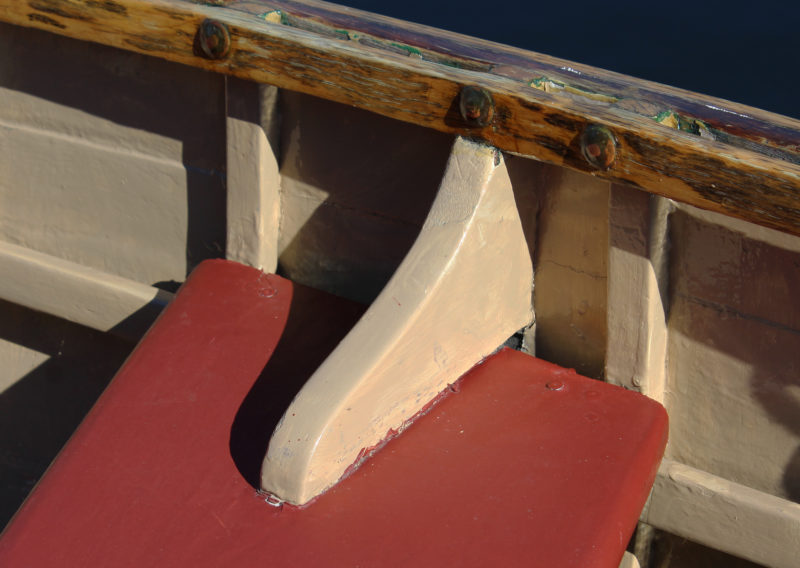 Christopher Cunningham
Christopher CunninghamShort, blunt-toed knees, like this one in a Davis boat, are quite common. Devoting a little more time and thought to knees will give them a lighter, more elegant appearance.
Knees and breasthooks made of solid blocks of straight-grained wood can be serviceable, but if the toes (the knee’s extremities) are fattened up too much to make up for the weakness of the cross-grain there, they don’t do much for a boat’s appearance. Pieces made from grown crooks are stronger because the grain runs with the loads, and much handsomer because they didn’t need to be bulky. Indeed, when carefully shaped they elevate the boat’s structure from “good enough” to art.
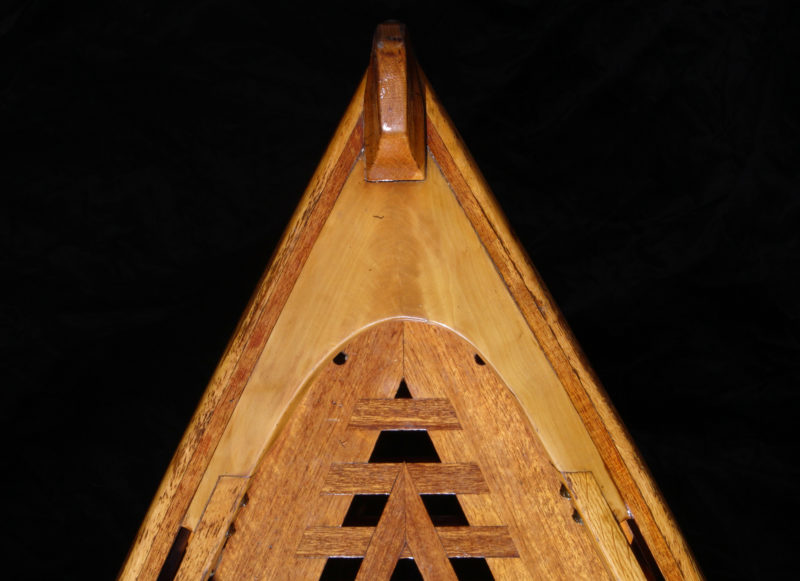 Christopher Cunningham
Christopher CunninghamThis apple-crook breasthook is in a New York Whitehall built in 1983. Well cured before it was installed, it hasn’t checked or separated from the surrounding structure.
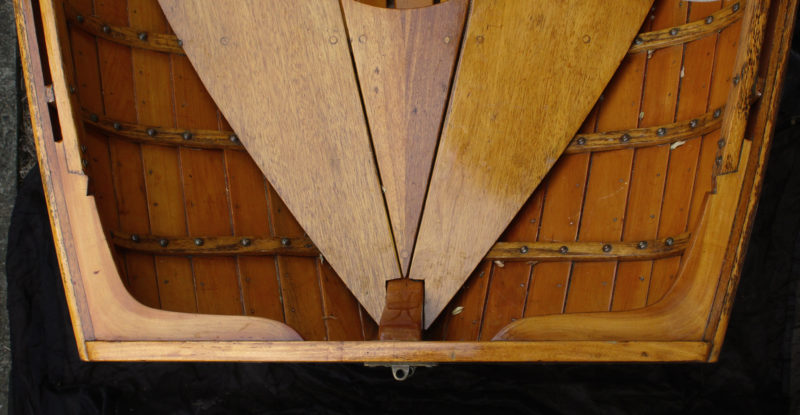 Christopher Cunningham
Christopher CunninghamThe grain in the Whitehall’s bookmatched fruitwood quarter knees not only follows the angle between the transom and the sheerstrake, it curves into the transom at the ends of the toes.
In former days when open boats commonly went alongside larger boats, seat knees were essential to the boat’s structure and were sometimes massive, keeping the sides from being stove in. Tenders and ship’s boats typically had two seat knees at each end of a thwart. With today’s light, glued-lapstrake construction they can be equally important in reinforcing the structure.
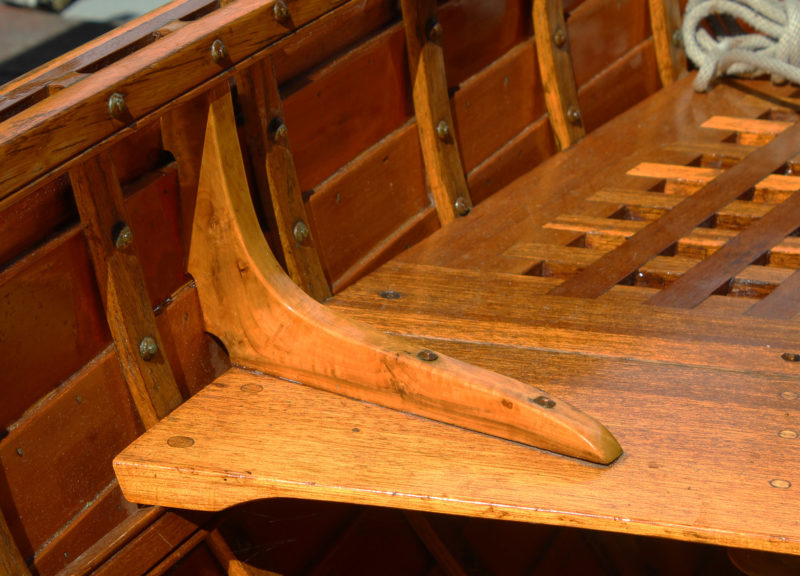 Christopher Cunningham
Christopher CunninghamThis fruitwood crook in the New York Whitehall braces a thwart that serves as mast partner. The toe is slender enough for rivets to be used to make the attachment.
The traditional thwart knee was a marvel of simple joinery. The part that supports the sheer plank was often carefully locked into the gunwale structure. Some were set on top of the thwart, either parallel to its edge or at an angle to it. Their toes might have decorative points cut at their ends. Others were fastened to the vertical edge of a thwart and carefully shaped in a show of lightness and elegance.L-shaped grown crooks were prized pieces of wood, but as they became scarce, many boatbuilders who built substantial numbers of boats went to metal knees. Today it is hard for most boatbuilders to find grown stock needed for traditional knees. Aside from requiring the trees to harvest, the crooks have to be cured without developing splits and sawn into flat pieces prior to shaping.
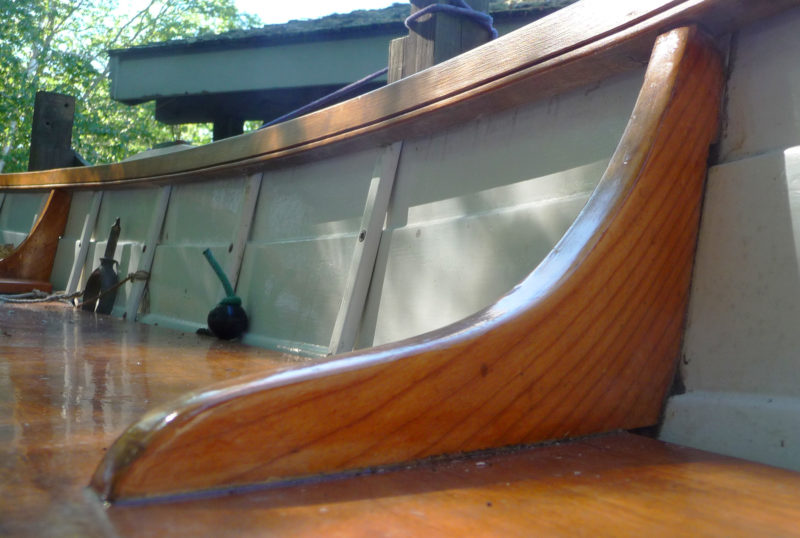 Ben Fuller
Ben FullerThe cross grain shows up clearly in this knee but it was made out of stock wide enough to give it a nice shape. The knees in the author’s Antonio Dias-designed Harrier are screwed to the seats from underneath.
In knees sawn from straight-grained stock, the toes are often blunt and thick, their length limited by the width of the stock used and their height, making up for weak cross-grain, requiring screw-fastening from underneath the thwart. It doesn’t have to be that way. With laminations and reliable glued joints, it isn’t hard to recapture the look and strength of natural knees. Steam-bent knees can provide a sweeping curve and slender toes, but they require blocking to provide the support of a solid knee. Stock can be created by laminating narrow strips of wood; knees can be built with half-lapped or splined pieces much the way that today’s builders emulate the natural crooks once used on dory frames.
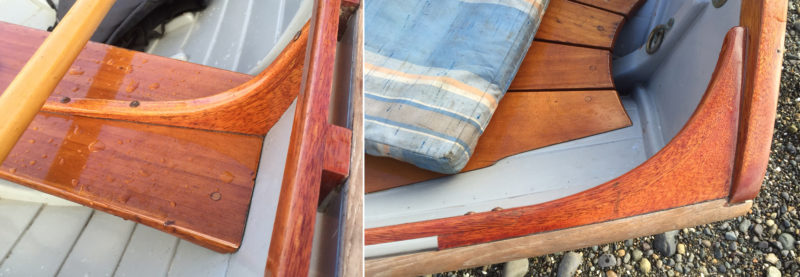 Ben Fuller
Ben FullerSteam-bent knees backed by a block of matching wood are every bit as functional and attractive as those made from a grown crook.
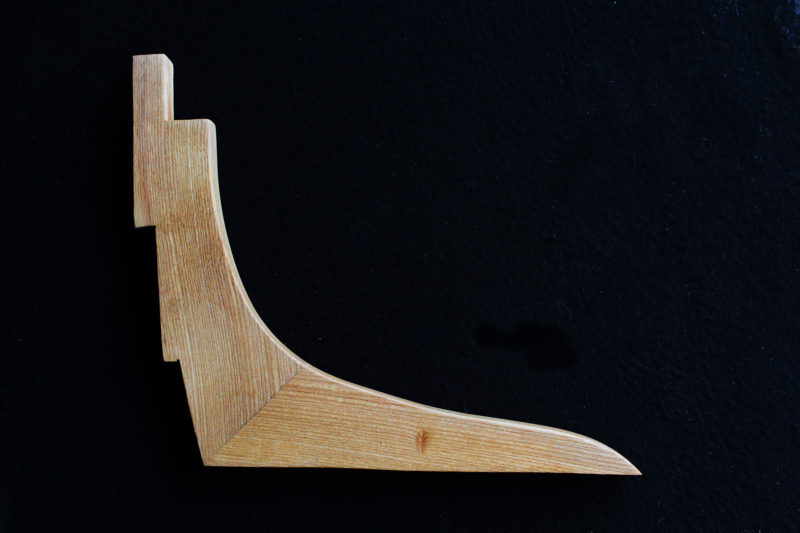 Christopher Cunningham
Christopher CunninghamThis mitered knee for a lapstrake boat has a broad spline running across the angled jolt. For details on making this type of knee, see this month’s From the Editor column.
Looking at these details on boats from an earlier time will train your eye. Spend the same kind of time on these details that you do on the rest of the boat; they’re what you’ll see every day. When master boatbuilder Joe Liener used to encourage novice boatbuilders to make parts like knees and breasthooks a little lighter, he wasn’t talking about trimming a few ounces of wood. It was his way of encouraging boatbuilders to consider grace and beauty in the work they do.![]()
Ben Fuller, curator of the Penobscot Marine Museum in Searsport, Maine, has been messing about in small boats for a very long time. He is owned by a dozen or more boats ranging from an International Canoe to a faering.
A Gallery of Breasthooks and Knees
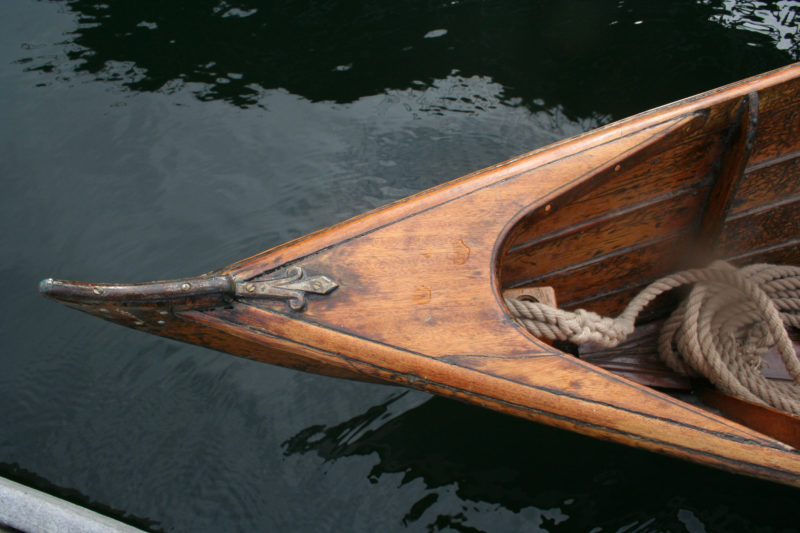 Christopher Cunningham
Christopher CunninghamThis wherry built by Cooper and Sons in Shrewsbury, England, in the late 1800s has a breasthook made of a single piece of straight-grained wood. The inner edge is scribed with a decorative groove.
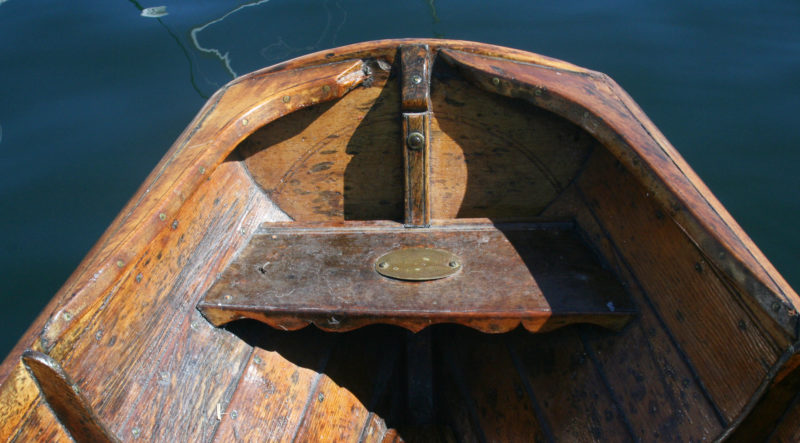 Christopher Cunningham
Christopher CunninghamThe quarter knees in the Shrewsbury wherry have exceptionally long toes.
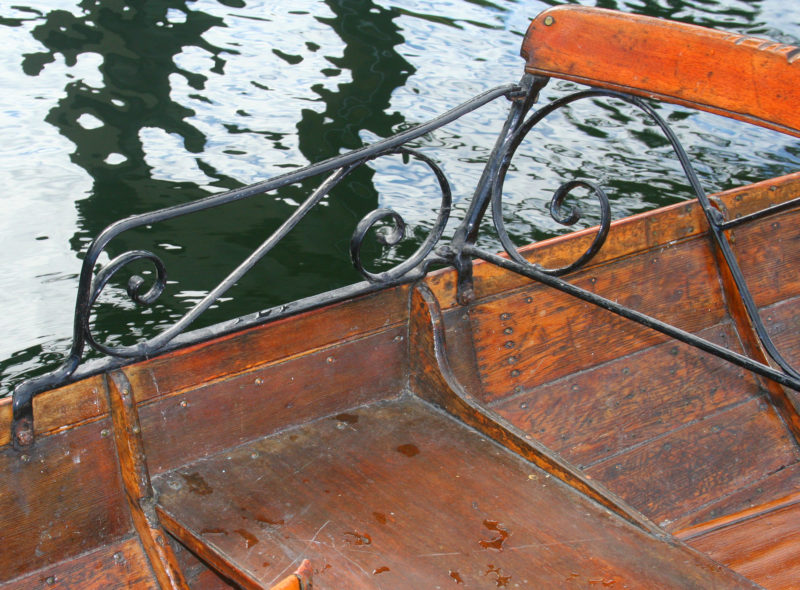 Christopher Cunningham
Christopher CunninghamThe wherry’s passenger seat has slender knees with long, elegant toes.
 Christopher Cunningham
Christopher CunninghamThwart knees are occasionally built into the edge of the thwart they support. This knee in the wherry is cut from a crook and becomes a frame head.
 Christopher Cunningham
Christopher CunninghamThis laminated mahogany knee in a Chamberlain gunning dory is wide enough to provide strength without a filler block backing it.
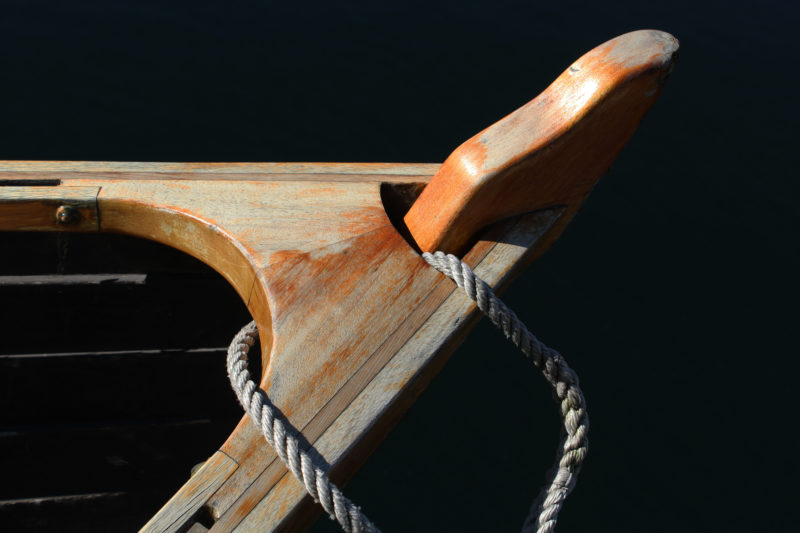 Christopher Cunningham
Christopher CunninghamThis breasthook in a Hvalsoe 13 is curved along its forward edge and set apart from the stem. This makes fitting easier, avoids an area that tends to weather poorly, and offers a convenient place to anchor a painter. The two halves of the breasthook are held together by epoxy alone, and while the joint has held up well for over 20 years, keeping the varnish in good shape will assure the bond doesn’t fail.
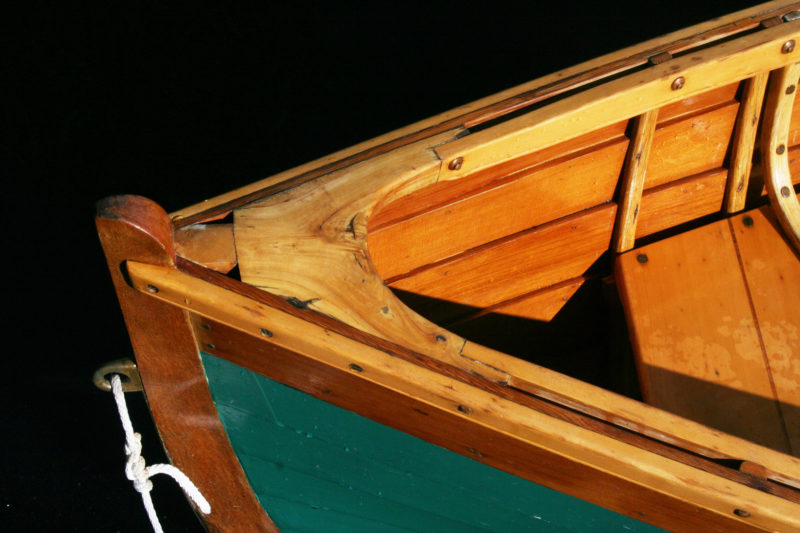 Christopher Cunningham
Christopher CunninghamThe grain of the crook used for this 1982 Whitehall’s breasthook is clearly visible.
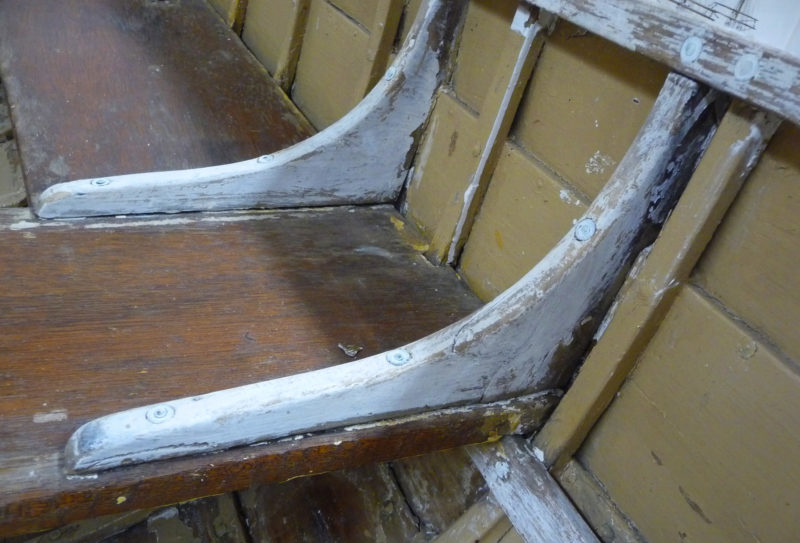 Ben Fuller/Penobscot Maritime Museum collection
Ben Fuller/Penobscot Maritime Museum collectionThese double knees are from a tender built in the mid-coast area of Maine in the 1930s. The boat is as nice as anything turned out by the more highly regarded boatbuilders of Massachusetts or Rhode Island.
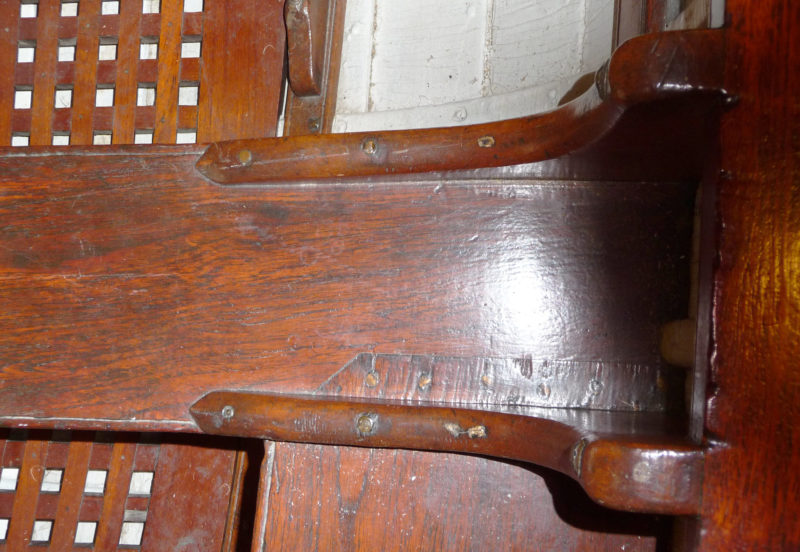 Ben Fuller/Penobscot Maritime Museum collection
Ben Fuller/Penobscot Maritime Museum collectionPointed toes add a distinctive touch to LITTLE ELVA, a 16′ captain’s gig built in 1881 by a carpenter aboard the Downeaster sailing ship CORA. The gig was built along the lines of a workboat, but intended for pleasure outings and given some fancy woodwork.
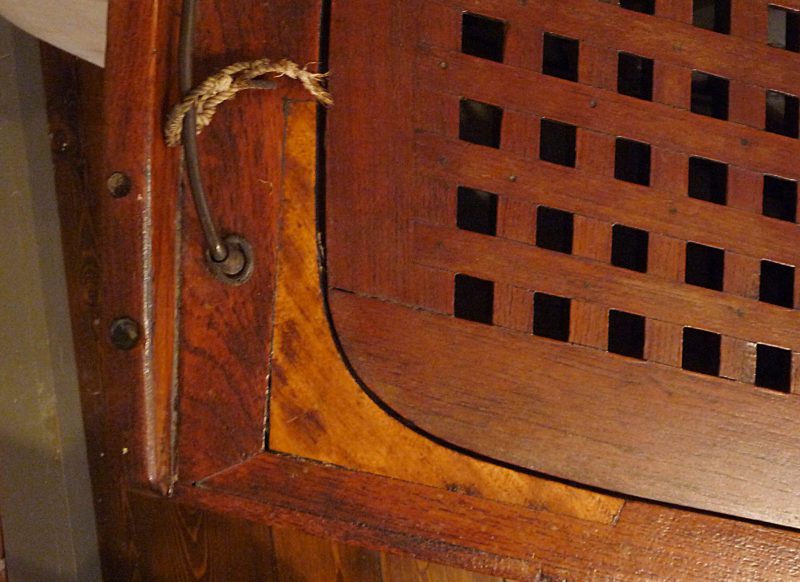 Ben Fuller/Penobscot Maritime Museum collection
Ben Fuller/Penobscot Maritime Museum collectionLITTLE ELVA’s dainty quarter knees were let into the inwales and a cleat across the transom.
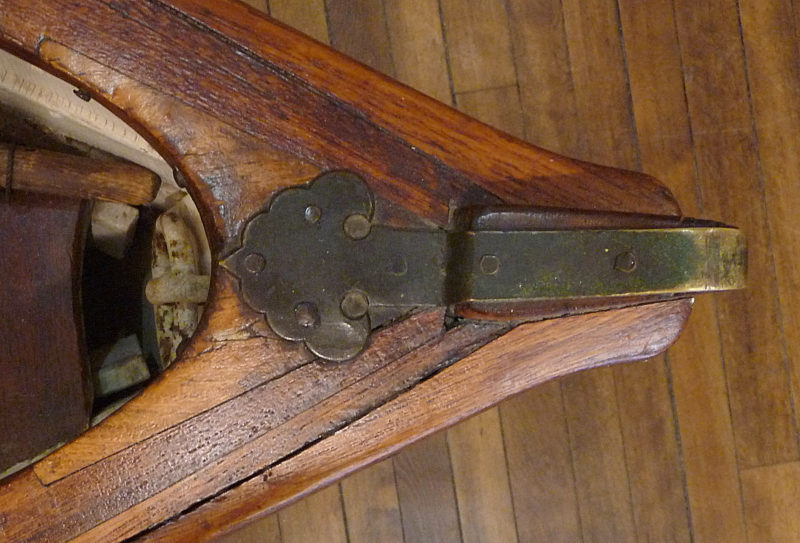 Ben Fuller/Penobscot Maritime Museum collection
Ben Fuller/Penobscot Maritime Museum collectionThe LITTLE ELVA breasthook was also let into the inwales.
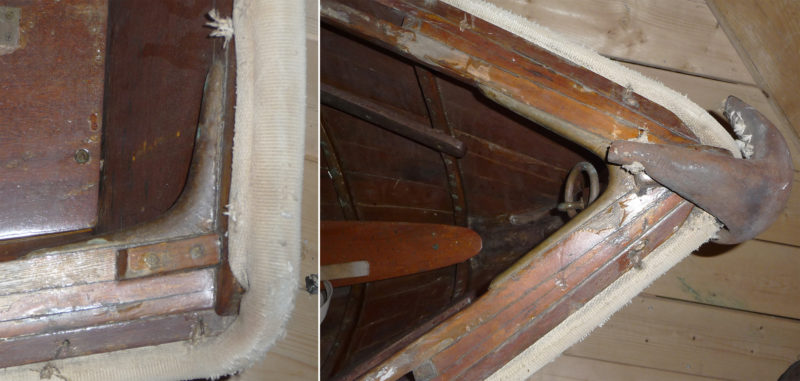 Ben Fuller/Penobscot Maritime Museum collection
Ben Fuller/Penobscot Maritime Museum collectionThe quarter knees and breasthook in this Lawley-built tender are bronze and well suited for a boat built in great numbers.
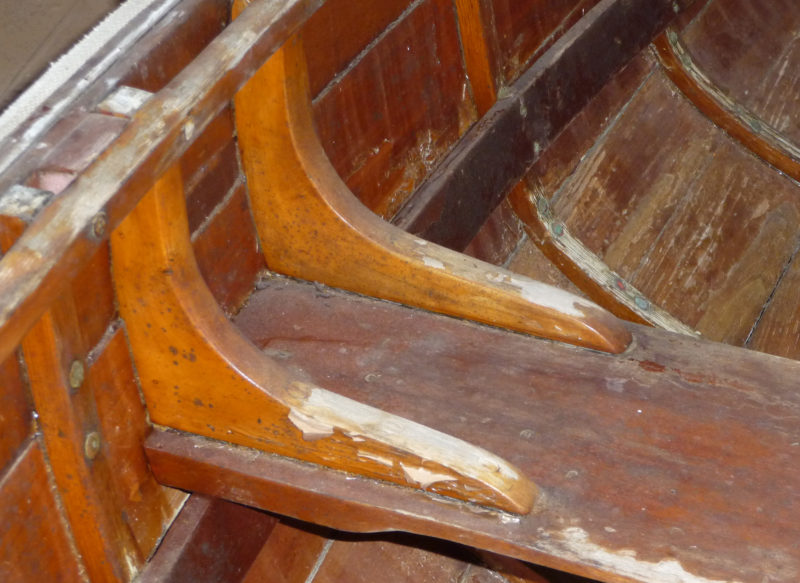 Ben Fuller/Penobscot Maritime Museum collection
Ben Fuller/Penobscot Maritime Museum collectionWhen Lawley switched to metal breasthooks and quarterknees, the tenders still had nicely shaped wooden thwart knees. Eventually these too were done in bronze.
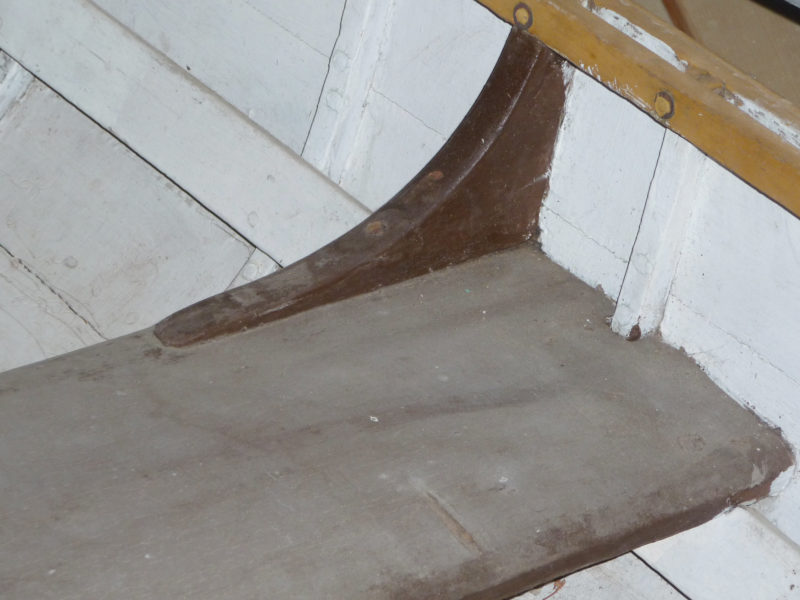 Ben Fuller/Penobscot Maritime Museum collection
Ben Fuller/Penobscot Maritime Museum collectionThis thwart knee on one of the small rowboats built in Vinalhaven, Maine, is a good example the of fine work that was just another day in the shop for the boatbuilder.
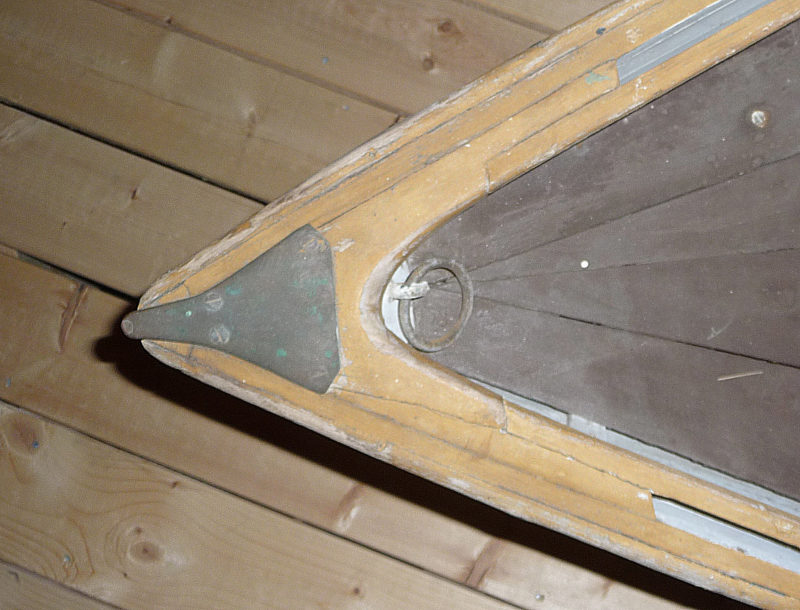 Ben Fuller/Penobscot Maritime Museum collection
Ben Fuller/Penobscot Maritime Museum collectionThe ordinary Vinalhaven rowboats were built with an eye toward lightness and interesting curves.
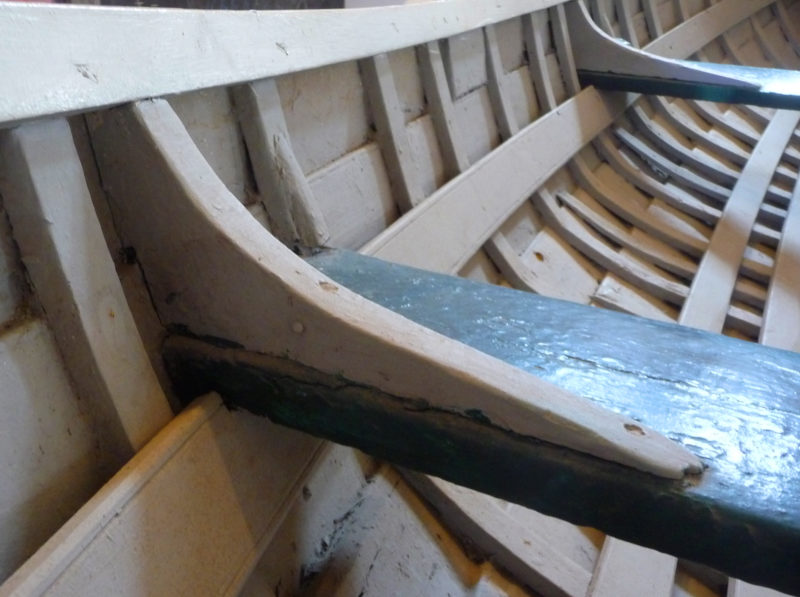 Ben Fuller/Penobscot Maritime Museum collection
Ben Fuller/Penobscot Maritime Museum collectionElegance was once the norm even on working peapods. The builders didn’t think about it, they just did it.
You can share your tricks of the trade with other Small Boats Monthly readers by sending us an email.
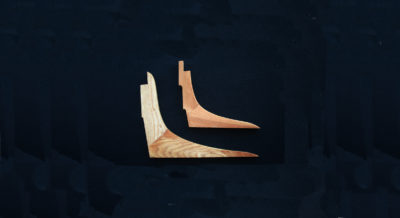
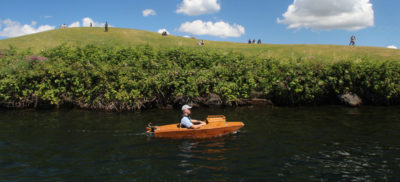

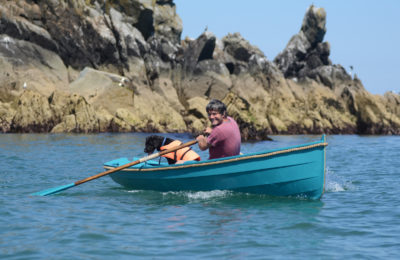
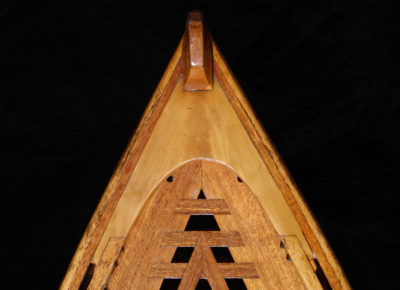
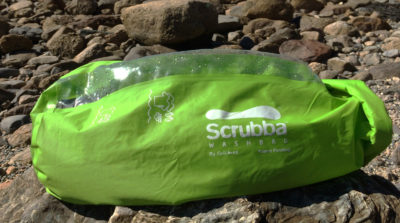
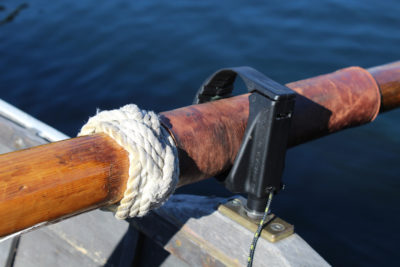
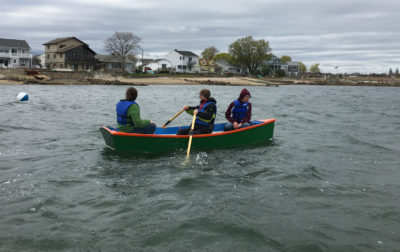
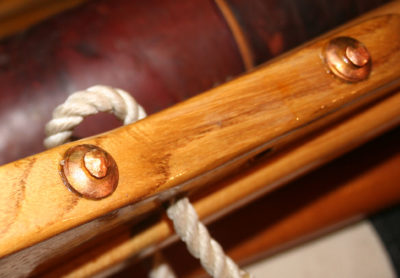
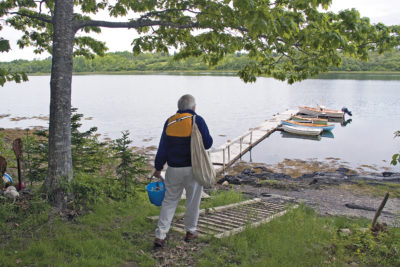

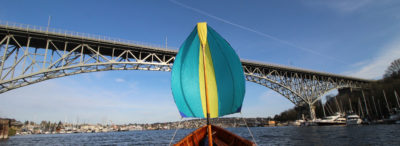
A great study and total eye candy. I’ll never be able to unsee good knees and breasthooks in a boat again!
Very nice article and pictures. Even in a very small wooden boat there is much beauty.
O’ the patina! Beautiful.
Thanks Ben. Certainly shows the many ways a beautiful knee or breasthook can be constructed!
Wonderful article. Thanks for the pictures and commentary!
Great article! Nice variety of knees and hooks. I wonder if you’ve seen a “hanging knee” like this before. I haven’t found any other examples. This one is on a Button Swan boat at Mystic Seaport. Thanks!


Hadn’t noticed that one despite having seen the boat dozens of times. Good catch. I’ll add it to my file. Just goes to show that the eye can continue to be trained. Time spent in a boat collection is time well spent.
Your article on knees and breasthooks was a very useful guide for those in the Seil I’m building in the back yard. These quarter knees are not yet complete. The miter joint is doweled with stainless all-thread.